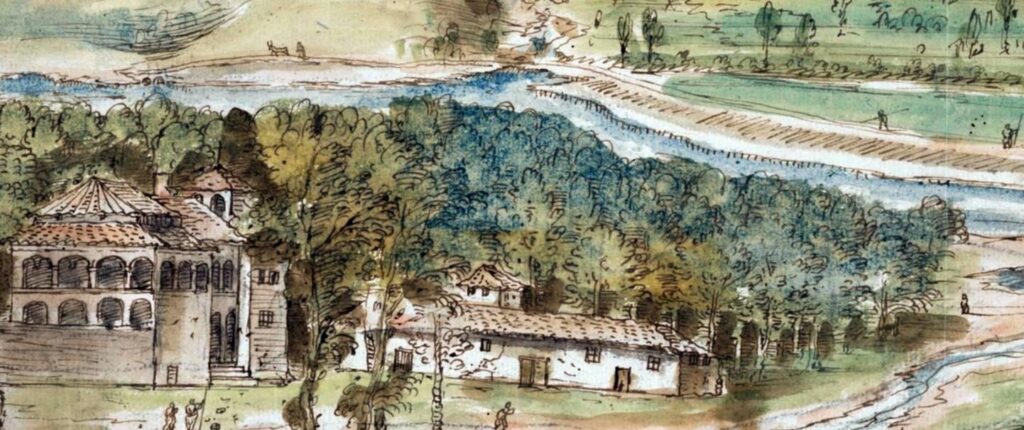Articles, Notes of history
Maestre Antonio, master builder and resident of the Villa
Article author: Mercedes Gómez
Date of publication of the article: 29/05/2024
Year of publication: 2024
Editorial note: The original article was published on 5 May 2024 on the website Arte en Madrid and was written by Mercedes Gómez.
It should be remembered that the Villa’s incumbent master builders, who were sworn in after being appointed by the Council, were called ‘maestros’, a title awarded to Mudejars who were experts in craft activities. Madrid owes much to these artisans of Muslim origin; as we have seen in some articles, the traces of their work in the historic centre of our city are important.
We met the Master Hazan – to whom the construction of the Hospital de la Latina, founded in the time of the Catholic Monarchs, is attributed – who is perhaps the most famous master builder, but not the only one who worked in the late 15th and early 16th centuries in the Villa and in the Real Alcazar of Madrid.
A few years after Hazan we find Maestre Antonio, who was also a senior master builder of the town and senior master builder of the Alcazar. No information is known about the place and dates of his birth or death, nor about his life; the little information known about his work suggests that he was probably of Muslim origin, like other master builders of the time, born in the last decades of the 15th century. His death must have occurred after 1549.
As master builder of the Villa, in 1511 he was, together with Francisco de Madrid, both ‘master builders and residents of the said Villa, skilled in the trade of carpentry and building work…’, appraiser of the goods of the monastery of La Latina, at the request of Iván de Vargas.
This appraisal reports that on 3 December 1511, Iván de Vargas, on behalf of Mrs Beatriz, appeared before the noble knight Pedro Díaz, mayor of the town on behalf of Queen Juana. This document is very valuable as it offers a complete description of the monastery of the Concepción Francisca and the house that was next to the hospital. It allows us to tour the rooms, kitchen, courtyard, orchard, stables, an oratory, the church, etc., in detail.
One of Madrid’s historic buildings, currently once again undergoing restoration and rehabilitation, is the Casa de los Vargas in the Casa de Campo; Fernando Marías attributes its construction, which took place around 1515-1520, to Maestre Antonio, who at that time had been appointed master builder of the Alcazar of Madrid.

In 1529, the master builders Antonio and Francisco were once again cited as master builders of the town in order for them to decide on the necessary works that should be undertaken to repair the bridges of Toledo and Segovia. We are talking about the primitive bridges, the Segovian bridge and the Toledo bridge, not the current ones, which are later works.
Pedro Ordóñez, mayor of Madrid, asked the people who crossed to the other side of the river to find out its condition. The bridges had ‘the pillars and knives… very worn and some of them fallen down’. Once the necessary reports had been obtained, Pedro Ordóñez sent ‘master Antonio and master Francisco, builders of this Villa, and Francisco de Atienza and Eugenio de Olivares, stonemasons’, to give their opinion on the necessary repairs.

In 2006, during the works for the undergrounding of the M-30, very important remains of these bridges were discovered. In the article on the Alarifes de Madrid, we asked ourselves: Who knows if there might not be some memory of these ancient builders in them? … it is nice to know that the traces of Antonio de Madrid are probably still there in some way.
From 1511 – the same year in which he took part in the appraisal of the goods of the monastery of La Latina – his name appears in various works as ‘maestro mayor de los alcaçares e alarife de la dicha villa’. From 1536 onwards, when the works began in the Alcazar with Alonso de Covarrubias and Luis de Vega as master builders, Maestre Antonio only appeared as a mason, a resident of Madrid.
We know the signature of ‘Maestre Antonio, mason and resident of Madrid’, in the deed of obligation granted by the Master for the work of the passage from the Golden Tower to the Cubo Redondo of the Alcazar of Madrid. In this document, he committed himself to carry out the works and to have them completed by the end of February 1541.

The last known mention of the master Antonio dates from 1549, as a guarantor for the stonemason Juan Francés in the church of Santa María Magdalena in Getafe, in the work on the main chapel, side chapels and sacristy.
This article is available in Español

